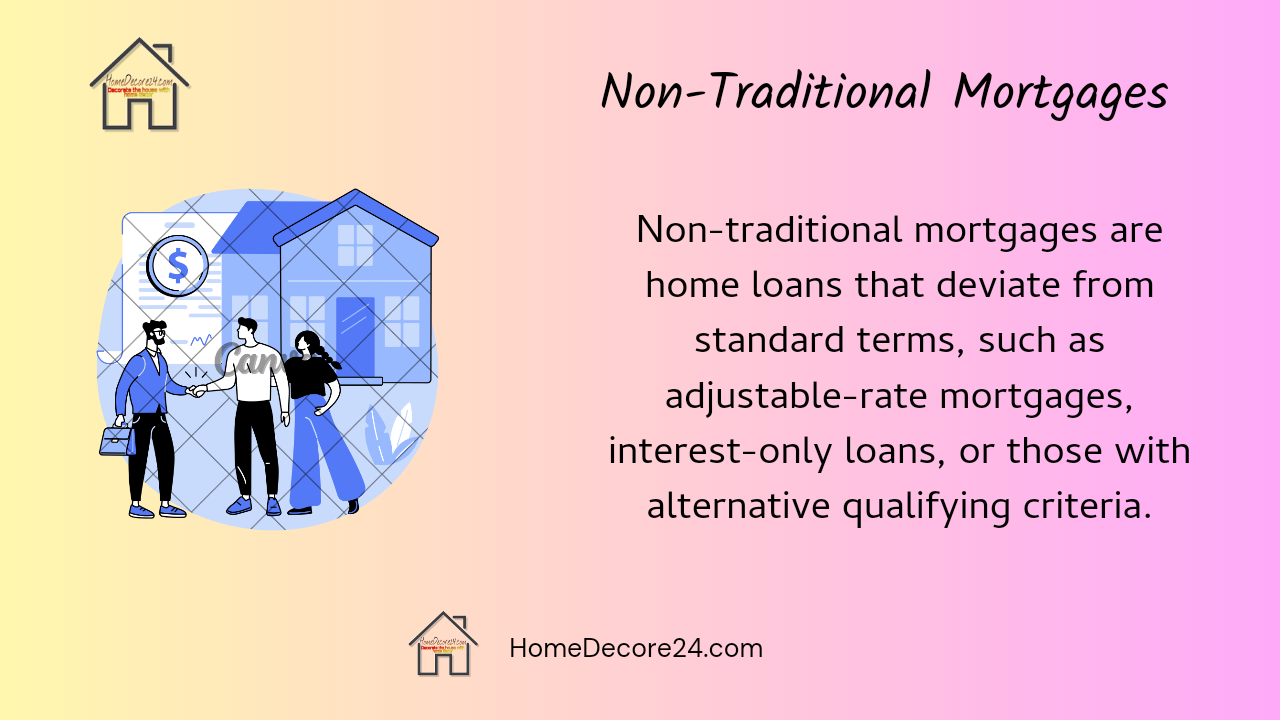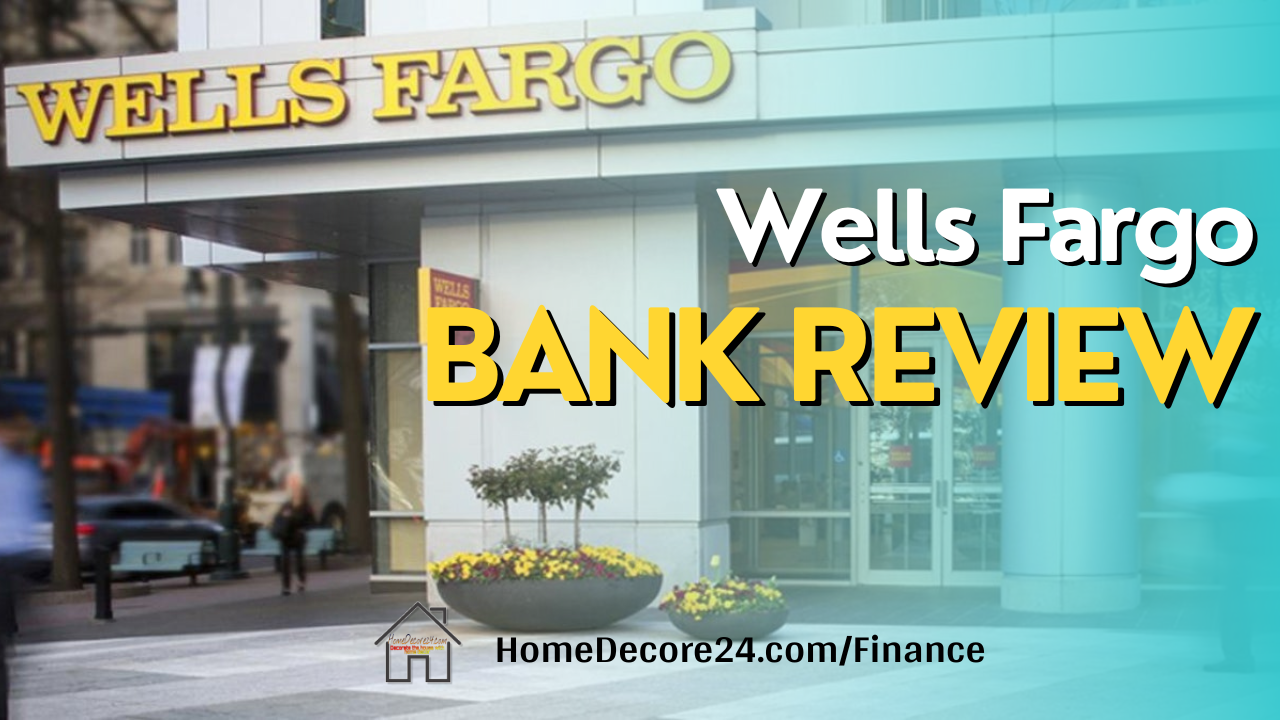
When it comes to obtaining a mortgage, traditional fixed-rate and adjustable-rate mortgages are the norm. However, for some borrowers, these conventional options may not be the best fit due to various financial circumstances. This is where non-traditional mortgages come into play. Non-traditional mortgages offer alternative lending options that can be appealing, but they also come with unique risks and considerations.
In this article, we’ll delve into the world of non-traditional mortgages, discussing their types, benefits, potential drawbacks, and what you need to know before applying for one.
Non-traditional mortgages are home loans that deviate from standard terms, such as adjustable-rate mortgages, interest-only loans, or those with alternative qualifying criteria.
What is a non-traditional mortgage loan?
A non-traditional mortgage loan deviates from standard fixed or adjustable rate structures. It includes options like interest-only, balloon, or option ARM mortgages, offering unique terms and potential benefits, but also increased complexity and risks.
Read More: FHA streamline Refinance: Rates and Pros-cons
Types of Non-Traditional Mortgages
Interest-Only Mortgages: With an interest-only mortgage, borrowers only pay the interest on the loan for a certain period, typically 5 to 10 years. After this initial period, the loan converts to a traditional principal-and-interest payment. This type of mortgage can offer lower initial monthly payments but requires careful financial planning for the future increase in payments.
Option ARM (Adjustable-Rate Mortgage): Option ARM mortgages allow borrowers to choose from several payment options each month, including minimum payments that may not cover the interest due. This can lead to negative amortization, where the loan balance actually increases over time. While these loans offer flexibility, they can also lead to significant debt if not managed properly.
Balloon Mortgages: Balloon mortgages have low, fixed interest rates for a set period (often 5 to 7 years), after which the remaining balance becomes due in a lump sum. Borrowers may need to refinance or sell the property to cover this balloon payment.
Benefits of Non-Traditional Mortgages
Lower Initial Payments: Non-traditional mortgages often have lower initial monthly payments, making homeownership more accessible for some borrowers.
Short-Term Solutions: These mortgages can be useful for those who plan to move or refinance within a few years, as they can take advantage of the low initial rates.
Flexibility: Option ARM mortgages offer flexibility in payment amounts, catering to individuals with irregular income streams.
Considerations and Drawbacks
Risk of Payment Shock: Many non-traditional mortgages have low introductory rates that can significantly increase after the initial period. Borrowers must be prepared for potentially substantial payment increases.
Negative Amortization: Option ARMs and interest-only mortgages can lead to negative amortization, where the loan balance grows instead of decreasing. This could leave borrowers owing more than they originally borrowed.
Property Value Fluctuations: Balloon mortgages could pose risks if property values decline or if the borrower can’t secure refinancing or a buyer when the balloon payment is due.
Complexity: Non-traditional mortgages can be more complex to understand compared to traditional mortgages, which might lead to misunderstandings or unexpected financial challenges.
What You Need to Know Before Applying
Understand the Terms: Thoroughly comprehend the terms of the loan, including the initial period, rate adjustments, and potential payment scenarios.
Financial Readiness: Assess your financial stability and future prospects. Ensure you can manage potential payment increases and the overall risks associated with the chosen non-traditional mortgage.
Exit Strategy: Have a clear plan for the end of the initial period, whether it’s refinancing, selling the property, or transitioning to a traditional mortgage.
Professional Advice: Consult with financial advisors and mortgage professionals who can help you understand the implications of the chosen mortgage type on your financial situation.
Read More: Construction Loans: Everything You Need to Know
Non-traditional mortgage vs. other types of loans?
Non-traditional mortgages differ from standard loans like fixed-rate or adjustable-rate mortgages. They have unique terms, such as interest-only or balloon payments, offering initial benefits but also added complexity and potential risks.
Are non-traditional mortgage a good idea?
Non-traditional mortgages can be appealing for certain situations, providing lower initial payments, but they come with risks like payment shock and negative amortization. Evaluate carefully before considering one.
Pros and cons of non-traditional mortgage
Pros:
Lower Initial Payments: Non-traditional mortgages offer reduced initial monthly payments, making homeownership more accessible.
Flexibility: Some options allow variable payment amounts to accommodate irregular income.
Short-Term Strategy: Can be suitable if planning to refinance or sell within a few years.
Cons:
Payment Shock: Initial low rates can drastically increase, causing payment shock.
Negative Amortization: Some options might lead to loan balance growth instead of reduction.
Complexity: Non-traditional mortgages are more intricate, potentially leading to misunderstandings.
Risks: Balloon payments and changing property values pose risks.
FAQ’s
What are the benefits of a non-traditional mortgage?
Non-traditional mortgages offer lower initial payments, flexibility in payment amounts, and can be a short-term solution for those planning to move or refinance in the near future.
What are the three main types of mortgage?
The three main types of mortgages are fixed-rate mortgages, adjustable-rate mortgages (ARMs), and interest-only mortgages. Each type has unique features and benefits for borrowers.
What is non-traditional mortgage?
A non-traditional mortgage deviates from standard fixed or adjustable rates. It includes options like interest-only or balloon mortgages, offering unique terms but also added complexities and risks.
What is the difference between traditional and non-traditional mortgage?
Traditional mortgages follow standard fixed or adjustable rates. Non-traditional mortgages, like interest-only or balloon options, have unique terms—initially lower payments but potential for higher risks due to payment fluctuations and complexities.
YouTube Video
Bottom Line
Non-traditional mortgages can offer opportunities for borrowers to enter the housing market or manage short-term financial situations. However, these options come with their own set of risks and complexities.
Before applying for a non-traditional mortgage, carefully weigh the benefits against the drawbacks and make an informed decision based on your financial situation, goals, and risk tolerance. Remember, transparency, understanding the terms, and seeking expert advice are key to navigating the world of non-traditional mortgages successfully.







